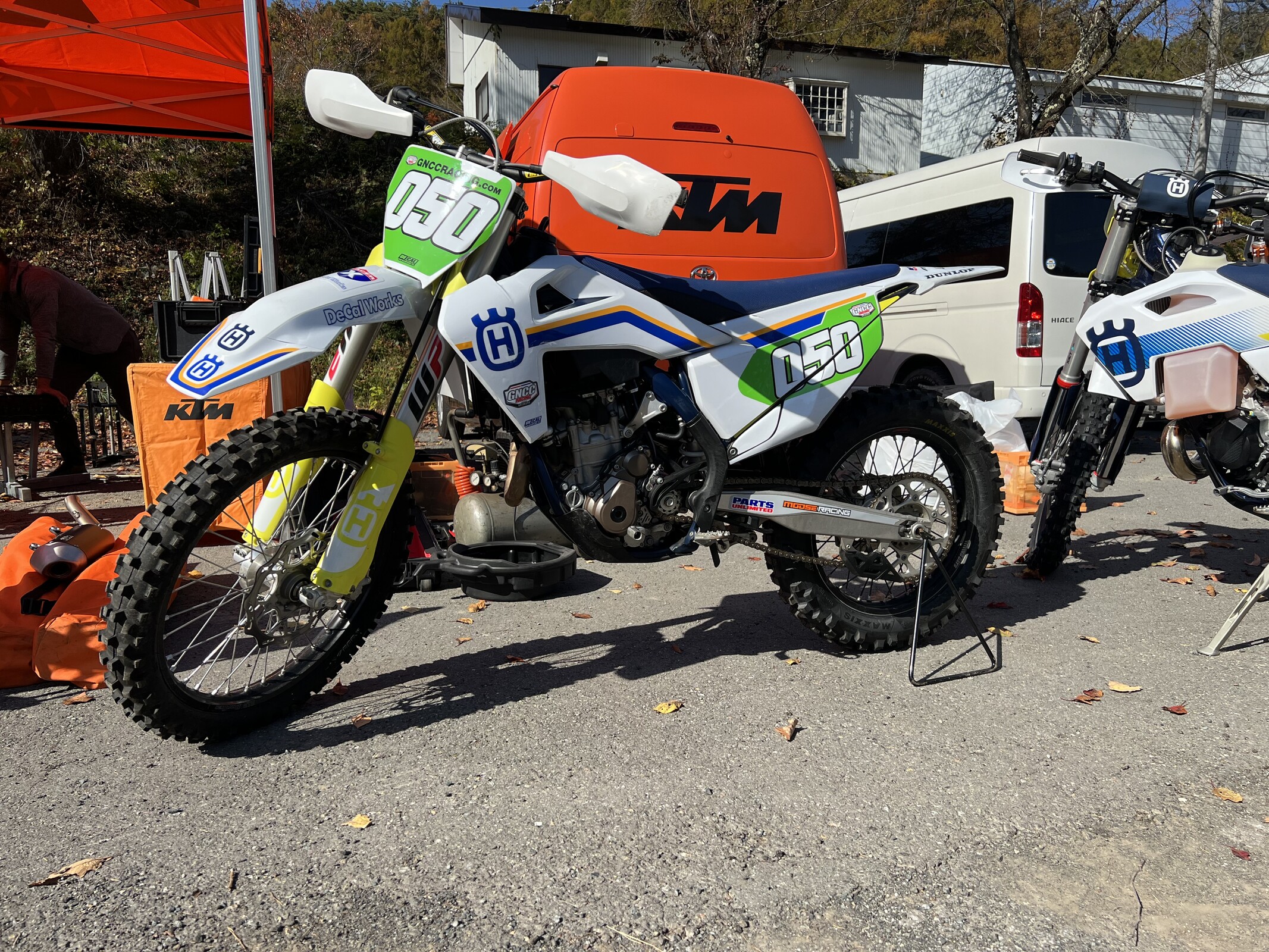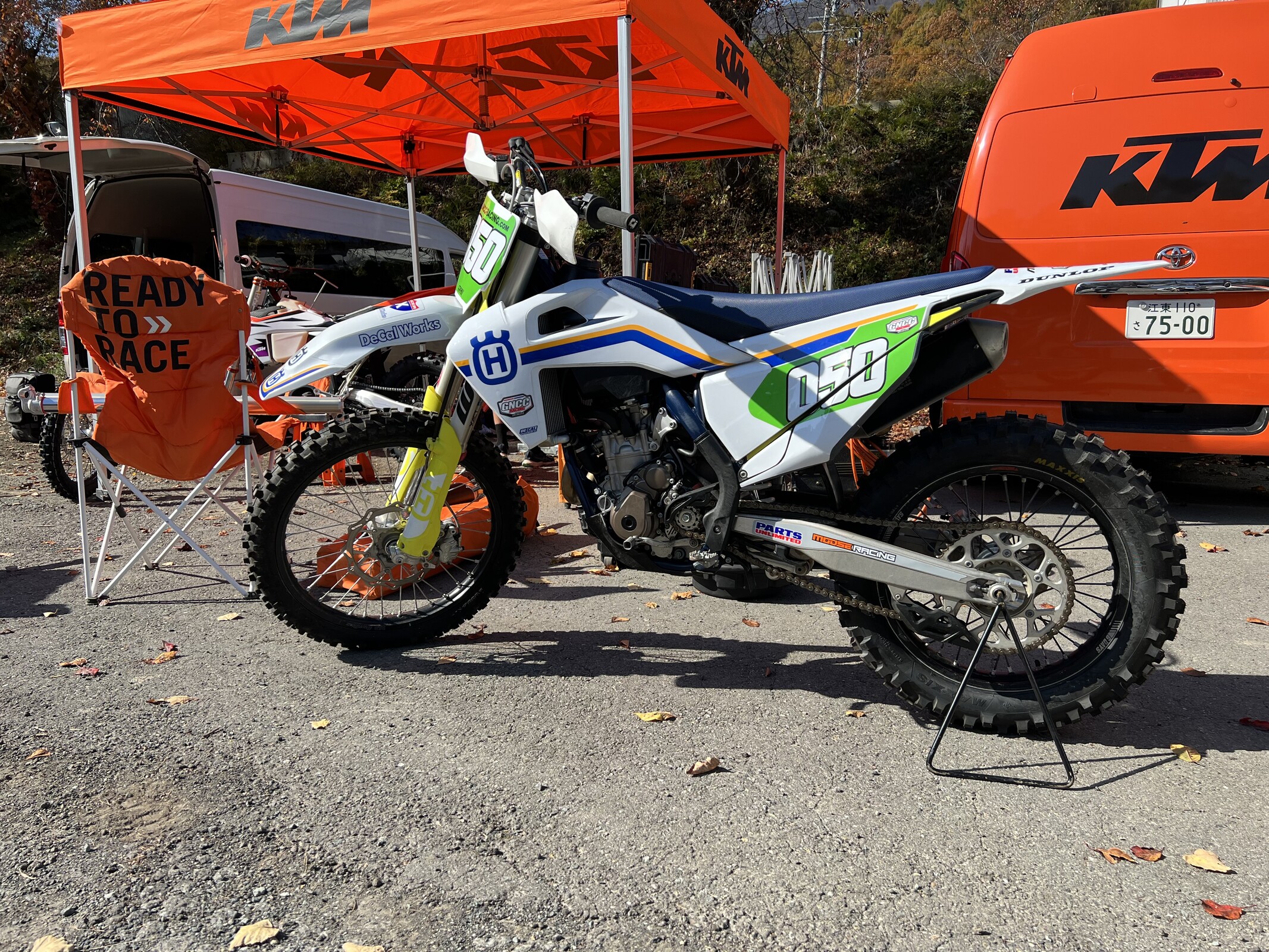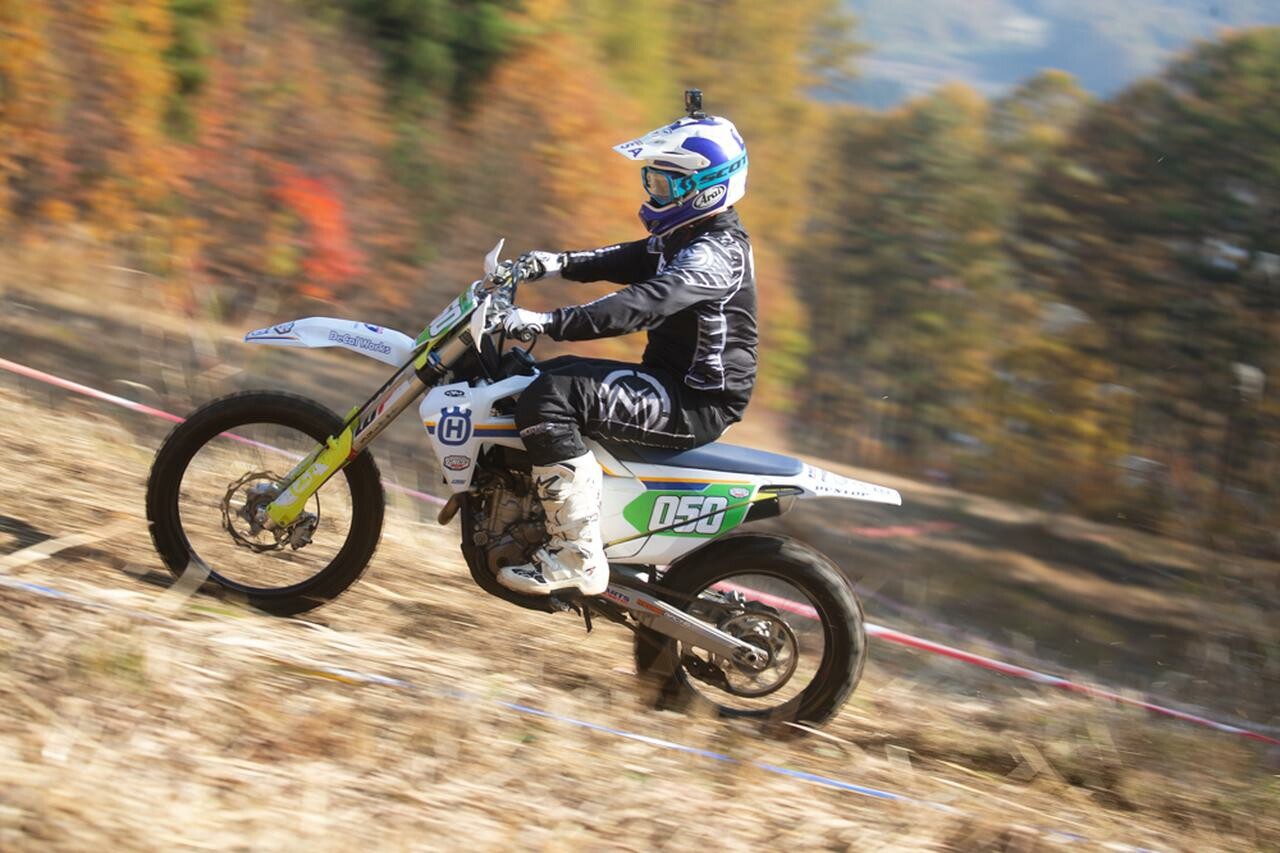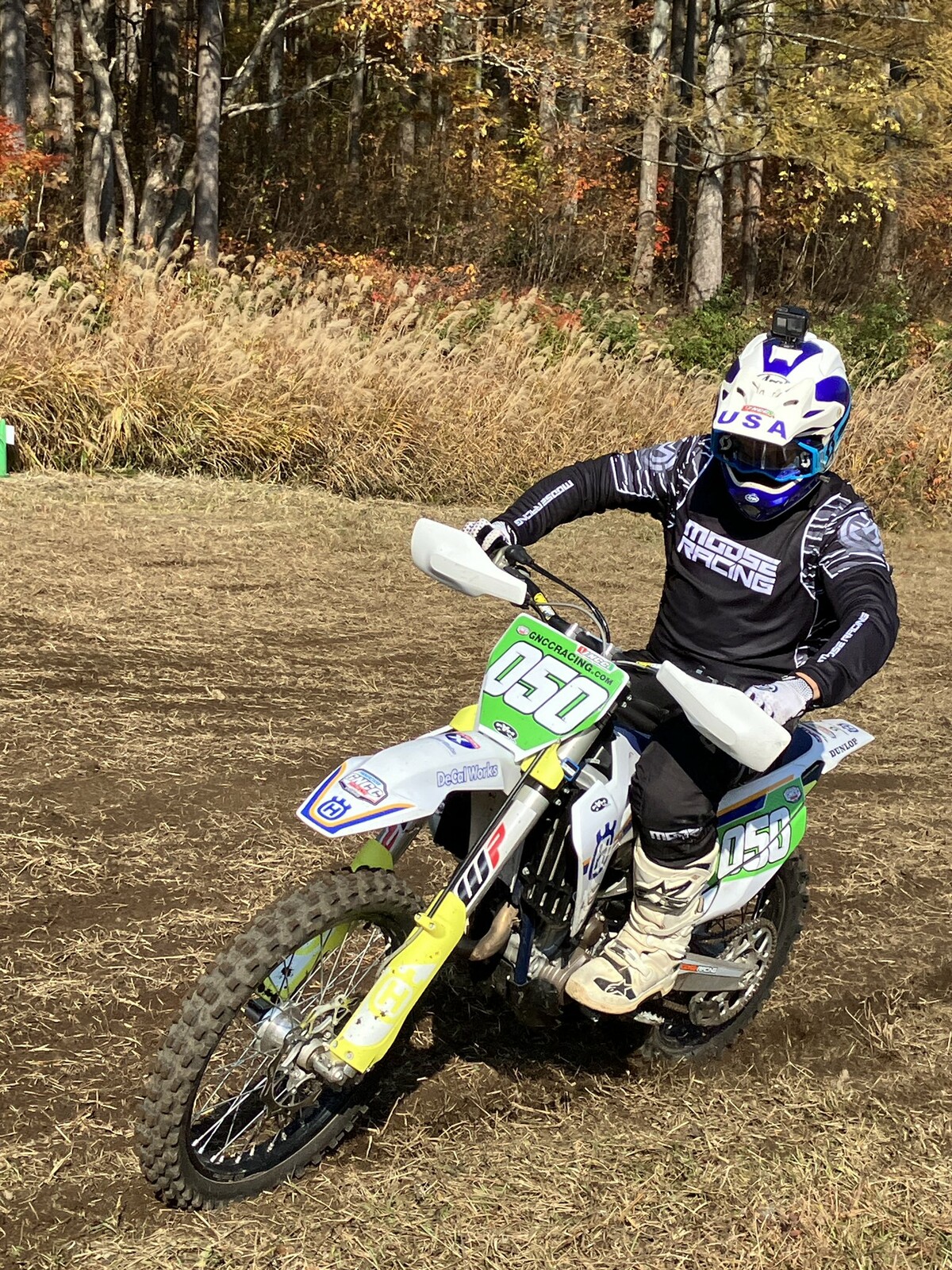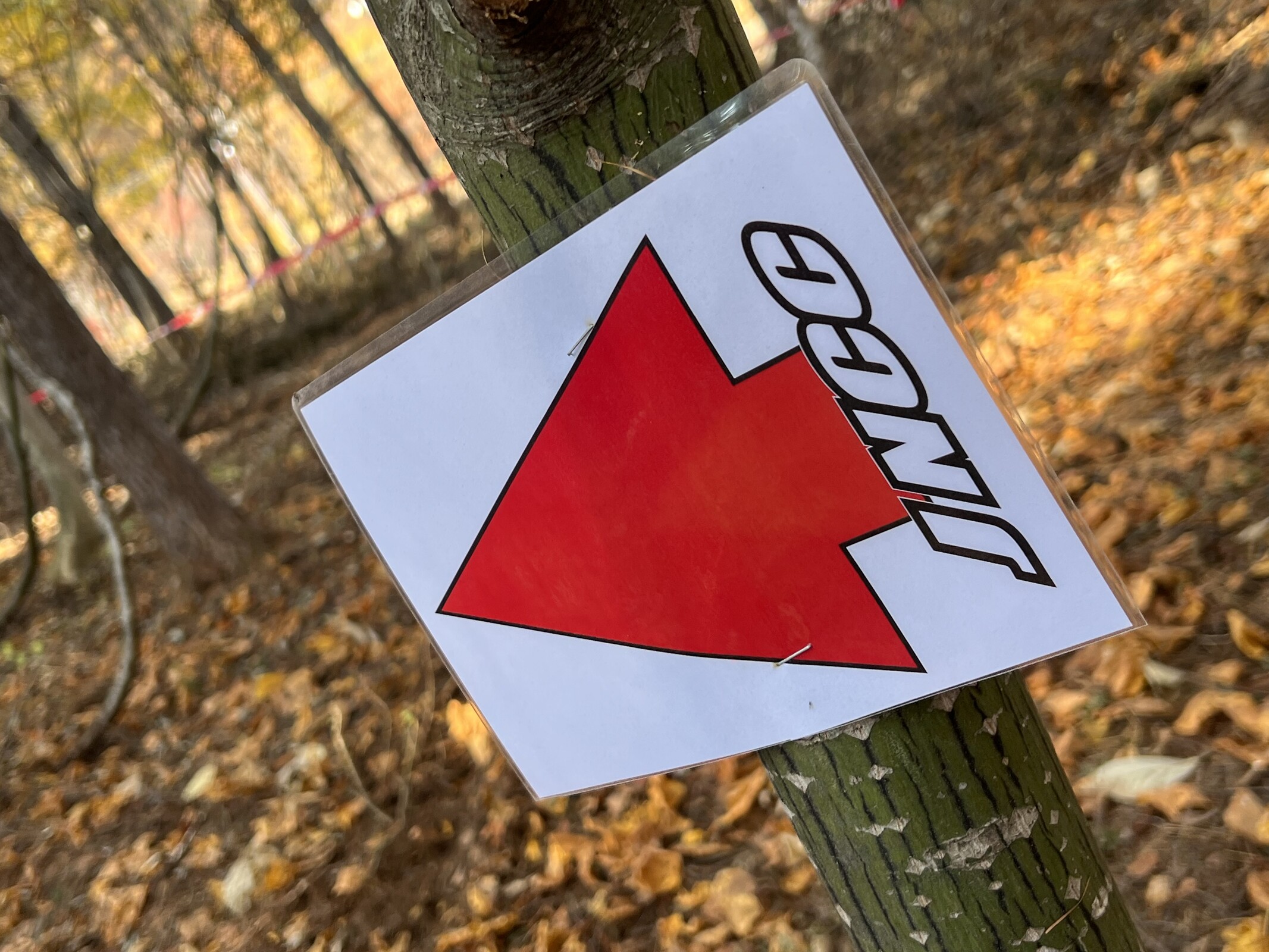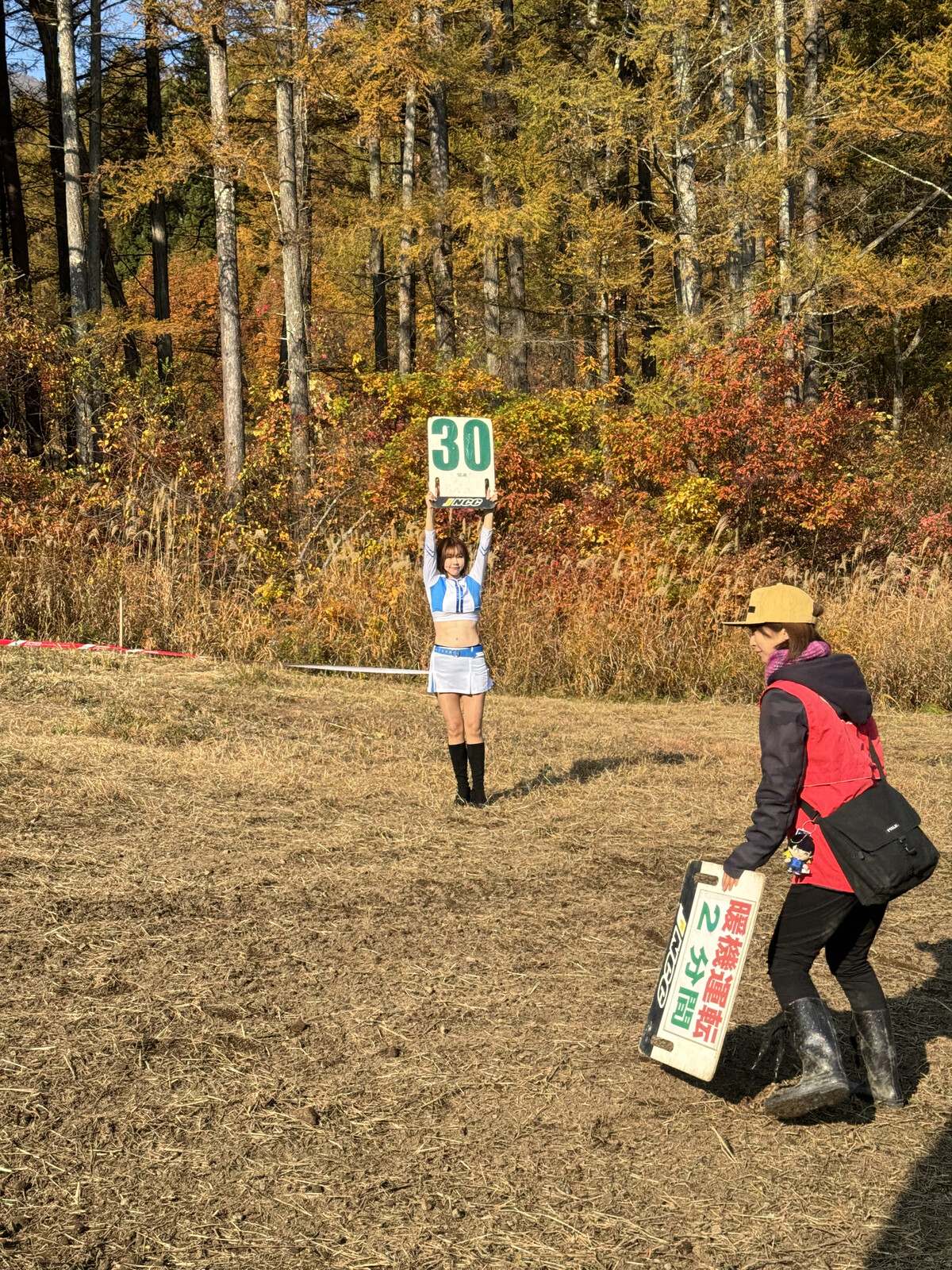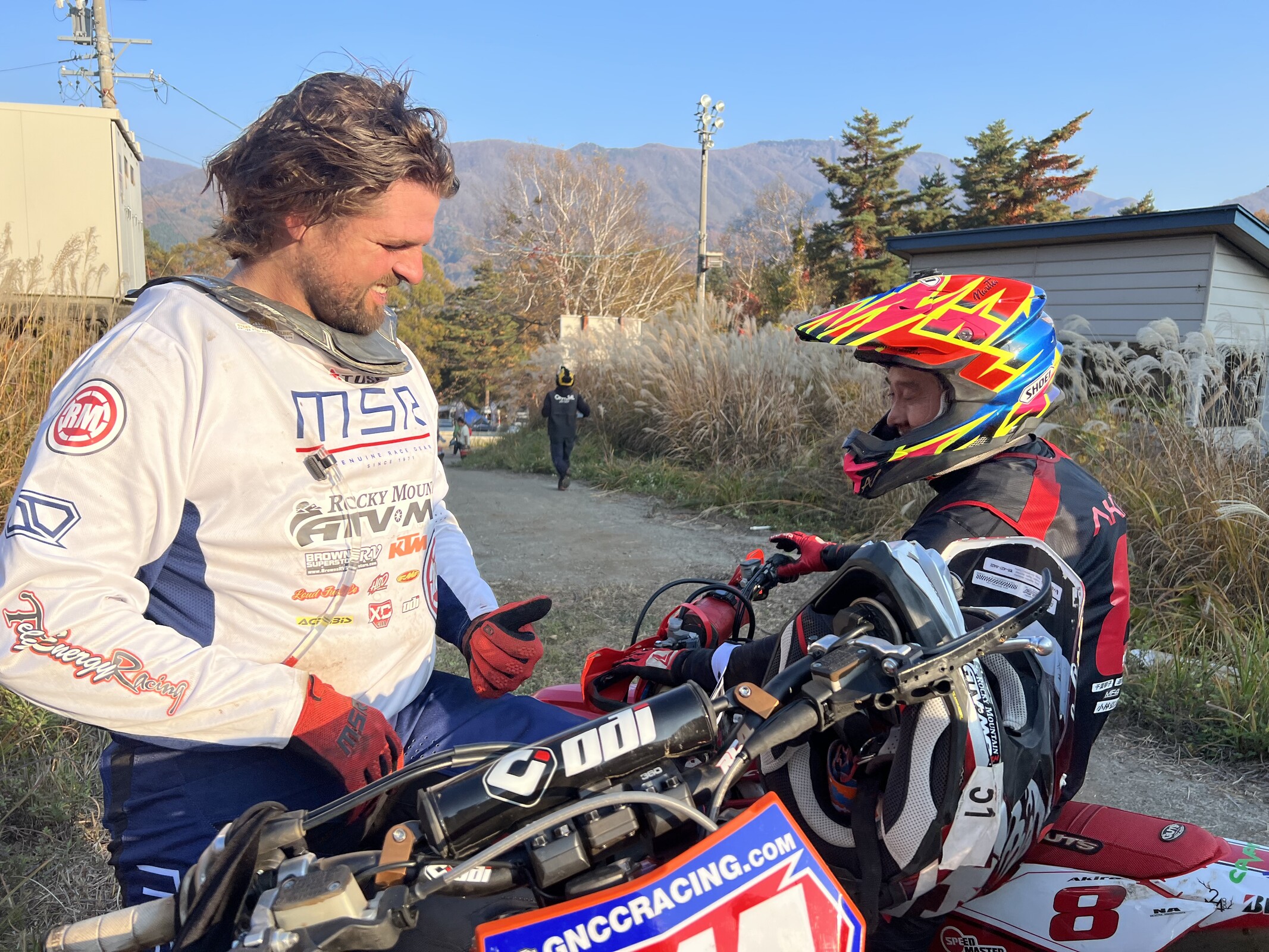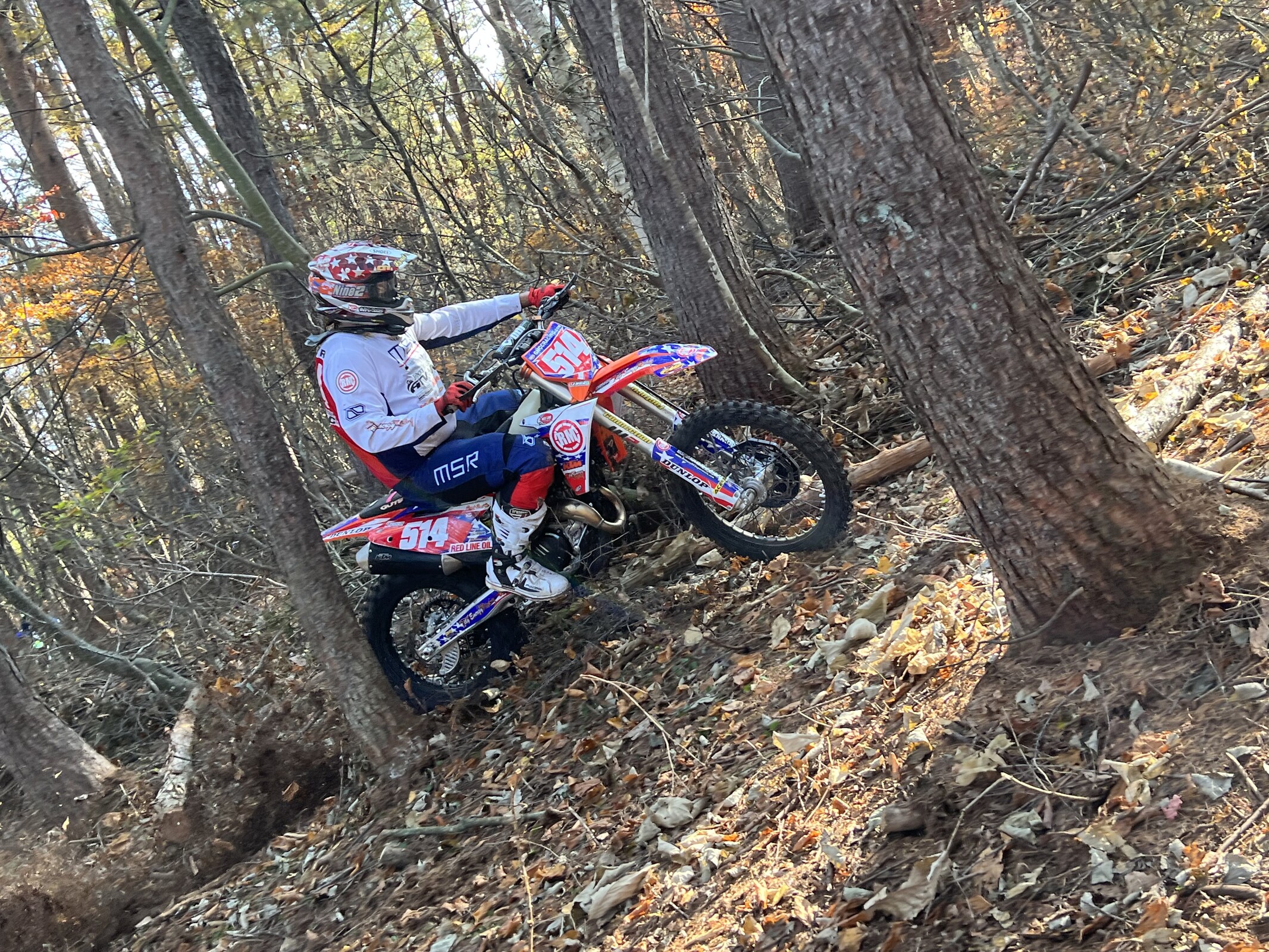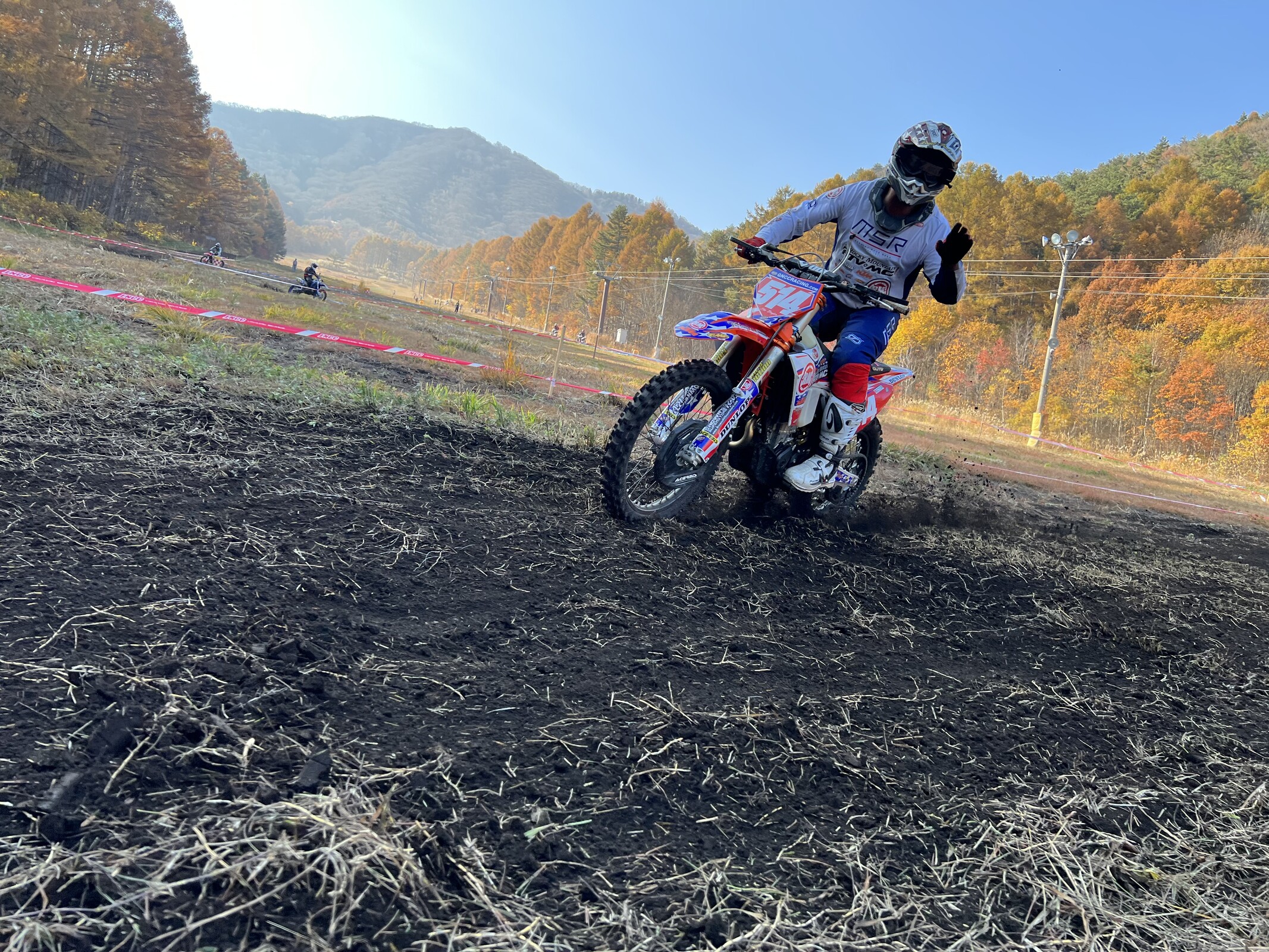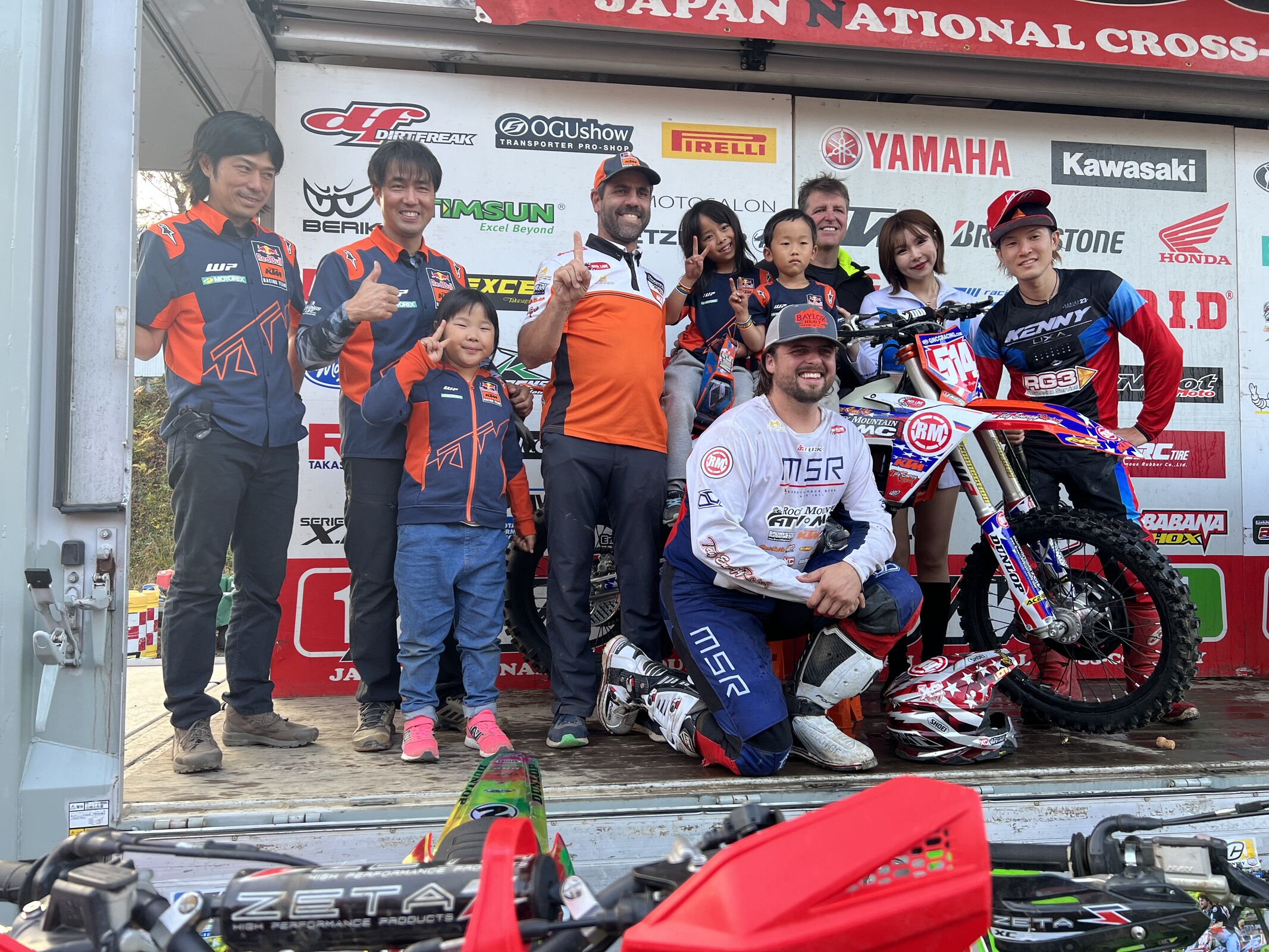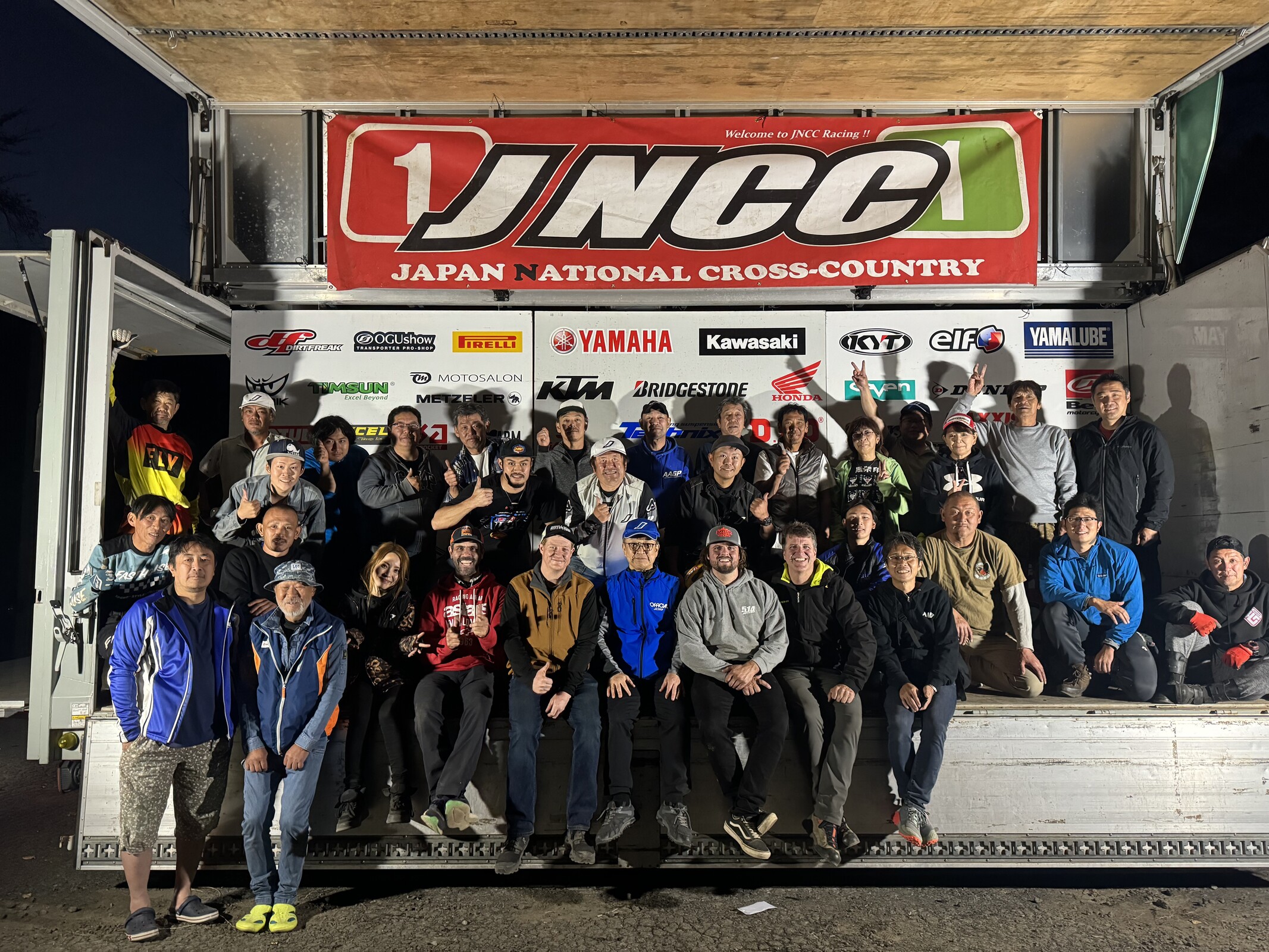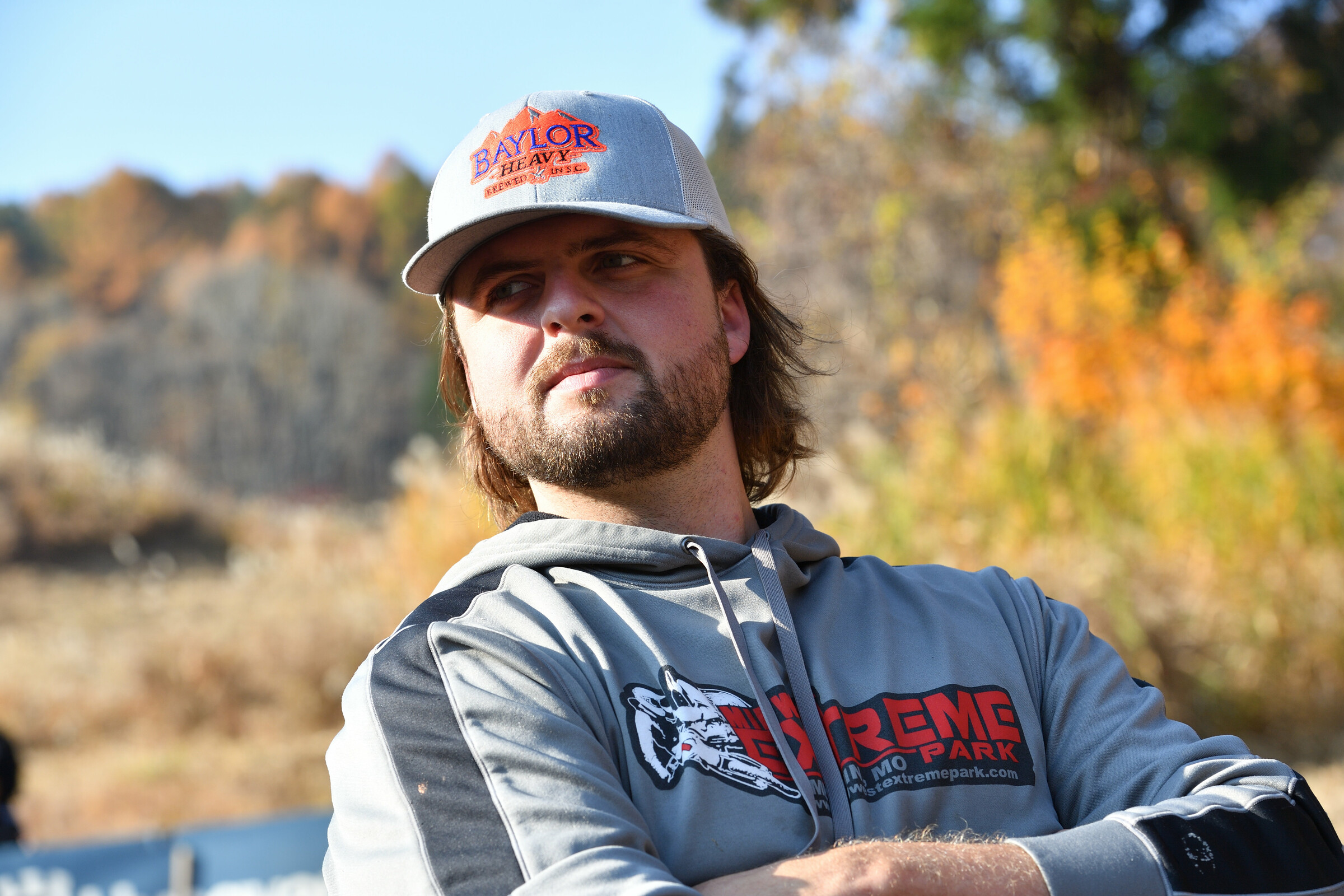テン 秒
(Ten Seconds)
Japan is synonymous with the motorcycle industry. Four of the world’s largest motorcycle manufacturers and numerous aftermarket companies call Japan home and the All Japan Motocross Championship gains attention as many new models debut here for the first time. Trey Canard recently made news by racing in an All-Japan Motocross event on Honda’s new electric motocross race bike prototype. Off-road racing has gained popularity in Japan as well. Modeled after the GNCC series in the U.S., the Japan National Cross Country (JNCC) series sees big turnouts of pro and amateur racers alike. There’s also a long standing tradition with the GNCC and JNCC series participating in a mutual racer exchange program.
Masami Hoshino is a long-time Japanese motorcycle industry professional with experience ranging from race promoter to parts and accessories importer and even as a rider himself. Masami is also big fan of American racing and Masami’s company, Rocky Sports, sponsored a number of American racers in the 90s. The Rocky Sports logo was prominently seen on the visors of American racers such as Damon Bradshaw and Micky Dymond plus Jeff Russell on the off-road side, among others. This is still occasionally discussed online as many American fans don’t recognize these logos.
Rocky Sports imported parts and apparel to Japan and when racers visited Japan for various events, the personable Masami struck friendships with some of his favorite racers. While Rocky Sports did not operate in the USA, Masami was such a supporter of American racers that he sponsored these racers and seeing the Rocky Sports logo on helmets of American racers resonated with Japanese riders. This gave Rocky Sports the prestige these kinds of sponsorships hope to find.
In 1984, Masami began organizing numerous enduro events in the Kanto Region of Japan, which would prove to be the closest off-road racing to Tokyo. His flagship event would be the Hurricane Enduro, named in honor of his friend and favorite American motocrosser, Bob Hannah. Masami even convinced Hannah to try his hand at the Hurricane Enduro in 1987 and would be the beginning of a new venture that would lead many new visitors to Japan off-road racing events.
Acting on invites from Masami and Japanese motorcycle executives, several top American racers would begin attending Masami’s races with a record ten attendances by seven-time AMA National Enduro Champion, Randy Hawkins. Masami and Randy would develop a close friendship, which lasts today as Randy’s AmPro Yamaha team frequently assists the visiting JNCC racers with race machines and support. Masami even created a gear line called HWK, named in Randy’s honor.
TIMES ARE A CHANGIN’
While enduro events were popular in Japan, there was no unified format, classification or competition rules as the various organizers each seemed do things a little bit differently. In 1995, Masami and his staff began advocating for the establishment of an “AA” class as the top level of competition as well as a standard set of classes and rules, much like the U.S. To incorporate their desire for more uniform events, the Hurricane Enduro was renamed the Hurricane AAGP.
In a tale very similar of GNCC Racing’s transition from the old 100-Miler Series, the Hurricane Enduro and like-events were often long and grueling, taking racers in excess of five hours to complete. After the influence of American racers such as Hawkins and Scott Summers, the events would experiment with a cross country style format with race times capped at two and a half or three hours. The All-Japan Enduro Championship would remain as-is, but the cross-country style events would see its own sub-series known as the All-Japan XC Enduro Championship begin in 2004.
By 2006 the series had grown enough that Masami was able to create his own separate series and the Japan National Cross Country Series was born. Utilizing the same format and many of the same rules and procedures as GNCC Racing in the U.S., the series would explode in popularity in a short period of time with hundreds of amateur races able to contest the JNCC events alongside top-tier professional AA ranked riders, just like GNCC. Meanwhile the famous AAGP event continues as it would be slated to standout as the JNCC season finale each and every season.
THE RACER EXCHANGE PROGRAM IS BORN
With this new series and its close ties to GNCC racers, the JNCC and GNCC series’ entered into a mutual racer exchange program. The JNCC series began inviting GNCC racers to contest the AAGP finale, and the GNCC series would do the same with JNCC racers trying their hand at a GNCC event each season.
While numerous American off-road stars had tried their hand at the enduro and AAGP events previously, the first GNCC racers in this mutual exchange program would be New Zealander Paul Whibley and Ohio’s Robbie Jenks, who gained the first selection in 2006. They would be followed by Jason Raines, Charlie Mullins and five-time GNCC champion, Rodney Smith in 2007 while JNCC competitors made their way to the USA for the first time in 2008 with Takeshi Koikeda finishing fifth place in the XC2 Pro class at the season-opening round in Florida.
Koikeda was no stranger to U.S. racing as he competed in the Pro Motocross and Supercross ranks in the late 90s, eventually making the transition to off-road racing, standing out as one of JNCC’s first superstar racers. After several GNCC appearances Takeshi, along with his wife and daughter, made the move from Japan to Mooresville, North Carolina in order to compete in the GNCC series full-time from 2012 to 2015, landing numerous top ten finishes along the way.
The racer exchange program would continue each year with top GNCC racers making the trip to Japan to race. For many, this would be their first-ever visit to Japan. Although most of these racers had tried their hand at the International Six Days Enduro, the JNCC events were uncharted territory and the whole experience is so enjoyable for racers that these racers return raving about the event and wanting to do it again. After his first visit in 2009, Josh Strang enjoyed the JNCC experience so much that he has now made four JNCC events, and two of those trip were events that he coordinated on his own outside of the GNCC selection.
In 2020, the Covid pandemic would push pause on the racer exchange program for four years. Attempts were made to put together efforts in 2021 and 2022 but Japan had yet to re-open for visitor travel, even with hosting the Olympics in 2021. By the time Japan officially reopened for travel in 2022, the JNCC staff was already in full planning mode getting ready to make their return to the USA for the opening round of the 2023 GNCC season at South Carolina’s Big Buck Farm. 2022 JNCC champion, Daiki Baba along with fellow pro racer Ryoto Suzuki made their first appearances in the USA, finishing a respectable 11th and 12th in the XC1 class.
With past attendees giving rave reviews, many top GNCC competitors would like to receive the nomination for the JNCC trip. Steward Baylor has been a GNCC racer since he was on minibikes and stands out as one of the most popular racers in the series. Baylor would prove to be an easy choice. Additionally, Stu was locked in a championship battle for most of the season and although a mechanical issue in the penultimate round hindered his championship opportunities, Baylor still won two rounds in 2023 and finished in the second-place spot an additional five times.
LET’S GO TO JAPAN
With the group set of Baylor, his mechanic Blake Plonsky, dad Big Stu and this article’s author (GNCC Race Operations Manager, Jared Bolton) the trek to Japan would begin with nearly 20 hours of travel including flights and layovers. Upon arrival in Japan, the JNCC staff had arranged none other than Japanese Motocross legend Akira Narita to act as a guide for the first portion of the trip, with usual JNCC guide Yoshi Kawana taking over once the group made it to the racetrack.
This year’s AAGP would be held at the X-JAM Takaifuji ski area just under an hour from JNCC’s home base in Nagano. The courses are a little shorter than the typical GNCC event, and built a little differently as JNCC Course Director, Hajime Hagiwara and his crew will ribbon two sides of a trail, around 50 or so feet wide and clean out all the small undergrowth in these areas. This allows racers to pick their way through the woods, utilizing countless different lines.
For me, this would mark my third JNCC visit with this time serving as more of a learning experience. The goal here is to learn more logistics of these visits with the hopes of making the GNCC visitors more self-sufficient, easing the burden on the JNCC staff in the future. Additionally, I was given the opportunity to compete in the JNCC FUN-GP morning race for the first time. Masami arranged a Husqvarna FC350 for my use supplied by Basist Auto, Japan’s largest KTM dealer, as well as some additional help from the KTM Japan folks supporting Baylor.
Although I spend a lot of time on motorcycles riding sweep at GNCC events, and tooling around on the minibikes at Pro Motocross, I hadn’t raced since 2021 so I would be a bit rusty to say the least. I also didn’t spend enough time testing the suspension on the Husky and it would be entirely too stiff, which left me struggling through the entire race. While I was able to hold my own in the wooded sections, the Japanese racers are very fast on the open ski slopes and with fairly dry conditions the course got more and more choppy as the race wore on, which was difficult to navigate with the stiff suspension. I’ve always rode the final portions of races better than the first and was able to dig myself out of a hole to end the day eighth place out of nearly 20 riders in the FUN-A class, which all things considered felt pretty good to land a top ten in the premier class of the morning race.
Given my lackluster performance, it was up to Stu to carry the weight here and he did exactly that. JNCC fans and racers alike are big supporters of American racers as they are impressed with the speed and skill, especially in the woods sections, so Stu received many cheers as he was introduced during the opening ceremonies. JNCC announcer, Shigehiro Nakai, utilizes the same “Ten Seconds!” call as GNCC, while Masami starts the race with the Japanese National Flag. When the flag flew, Takashi Yamaguchi grabbed the holeshot as Baylor would round the first turn with the back of the pack.
Watch some GoPro highlights of Baylor from a competitor's perspective.
The afternoon COMP-GP utilized additional sections of long woods, as well as running one of the Morning FUN-GP sections backwards. They also added in a special section of woods they called the “Baylor Woods” and these sections played into Baylor’s skills as he was in the lead before the end of the first lap, coming through the field of nearly 20 AA1 and AA2 racers. Five-time JNCC champ Watanabe Manabu would keep Stu honest as he was within just a few seconds of Baylor all the way through the completion of the opening lap. Watanabe was working towards a record sixth JNCC title, and after staying close to Baylor early would settle into focus on the bigger picture.
On the second lap, Baylor built up a bit of a lead and his closest challenge through the rest of the race would come from Kazuto Yano, a hard enduro racer who typically does not contest the whole JNCC series. However, Yano came out to race the AAGP just to compete against Baylor. Regardless, once Stu settled into a good pace, he built up a sizable lead over the competition and would hold it all the way to the checkered flag.
In the end, Baylor would take the win by five minutes over Yano. AA2 class racer Masahiro Kobayashi would end the day with the AA2 win and a solid third place overall. This would give the long-time JNCC racer the AA2 championship and a solid second-place overall position in the final championship point standings. Watanabe finished fourth overall, which would be good enough to wrap up his sixth JNCC championship and in doing so, has now earned more JNCC championships than any other rider.
Fifth place overall honors would go to Beta rider Yutaro Saito who also ended the year second place in the AA1 class points, while Akira Narita finished with a solid sixth place overall, fifth place in the AA1 class and third place in the final AA1 class standings. For Akira, this would conclude the legendary Japanese racers’ professional racing career. With 12 All Japan Motocross Championships to his credit, plus several top 10 U.S. AMA Pro Motocross Championship finishes and a Supercross podium, Akira is undoubtedly one of the best racers Japan has ever produced. Starting in 2024, Akira will be working with the JNCC staff which will ultimately prove to be a great partnership for the series and Akira himself.
With the race in the books, the post-race and podium celebrations seemed to fly by quickly as the trip began to wind down. With this being the final page of the 2023 season for JNCC and GNCC racers alike, 2024 is just around the corner and while the JNCC staff has not yet made their decision on which GNCC event to attend, they very well could be back for the season opening round in just a short three months. One of the great things about motorcycle racing is that you develop friendships with people from across the world, even though conversing with them is a challenge due to a language barrier. The fun of riding and racing knows no barriers and the comradery of racing can bring people from all walks of life together, creating lasting friendships which is the exact result this program produces.
GNCC TO JNCC RIDER SELECTIONS
2006 – Paul Whibley and Robbie Jenks
2007 – Jason Raines, Charlie Mullins, Rodney Smith
2008 – Nate Kanney and Thad Duvall
2009 – Josh Strang and Kailub Russell
2010 – Cory Buttrick
2011 – Jesse Robinson and Jason Thomas
2013 – Rory Mead and Josh Strang
2014 – Jordan Ashburn
2015 – Chris Bach
2016 – Trevor Bollinger
2017 – Ricky Russell
2018 – Craig Delong
2019 – Andrew Delong
2023 – Steward Baylor
ADDITIONAL American AAGP COMPETITORS
Randy Hawkins – 10 times
Larry Roeseler – 4 times
Scott Summers – 3 times
Bob Hannah
Guy Cooper
Malcolm Smith
Jimmy Lewis
Steve Hatch


